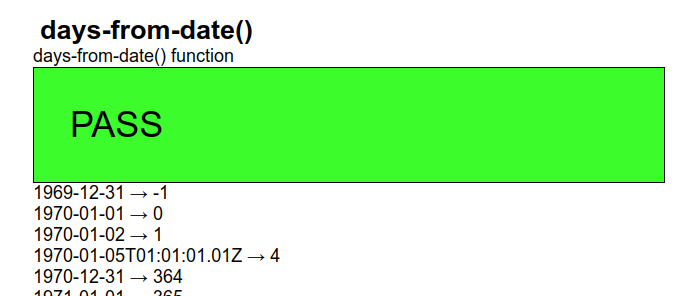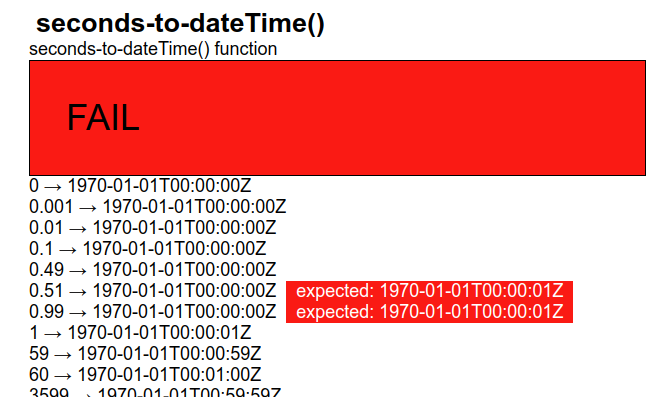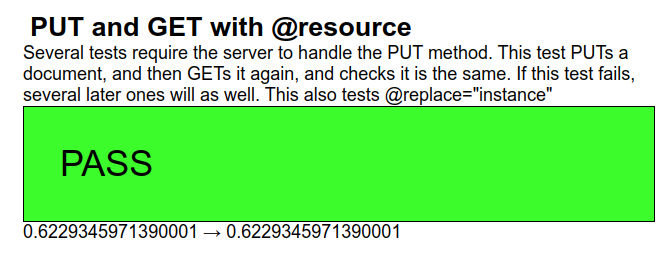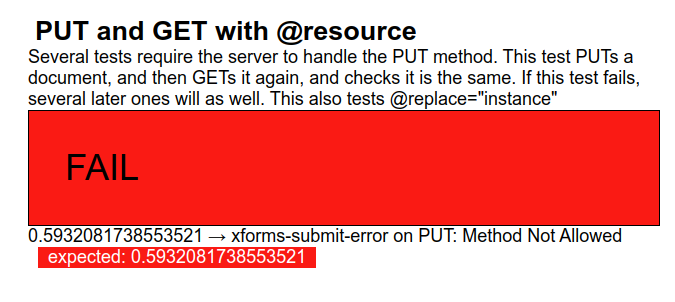How to cite this paper
Pemberton, Steven. “How Suite it is: Declarative XForms Submission Testing.” Presented at Balisage: The Markup Conference 2020, Washington, DC, July 27 - 31, 2020. In Proceedings of Balisage: The Markup Conference 2020. Balisage Series on Markup Technologies, vol. 25 (2020). https://doi.org/10.4242/BalisageVol25.Pemberton01.
Balisage: The Markup Conference 2020
July 27 - 31, 2020
Balisage Paper: How Suite it is: Declarative XForms Submission Testing
Steven Pemberton
Researcher
CWI, Amsterdam
Steven Pemberton is a researcher affiliated with
CWI, Amsterdam. His research is in interaction, and how the underlying
software architecture can support users.
He co-designed the ABC programming language that formed
the basis for Python and was one of the first handful of
people on the open internet in Europe, when the CWI set it up
in 1988. Involved with the Web from the beginning, he
organised two workshops at the first Web Conference in
1994. For the best part of a decade he chaired the W3C HTML
working group, and has co-authored many web standards,
including HTML, XHTML, CSS, XForms and RDFa. He now chairs the
W3C XForms group. More details at
http://www.cwi.nl/~steven
Copyright © Steven Pemberton, 2020
Abstract
Submission, the process of sending data to a server and dealing with the
response, is probably the hardest part of XForms to implement, and certainly
involves the XForms element with the most attributes. This is largely due to
legacy: XForms was designed to work with existing standards, and HTTP
submission was designed before XML existed: the data representations are
several, and on occasion byzantine.
Part of the process of producing a standard such as XForms is a test suite
to check implementability of the specification. The original XForms test suite
consisted of a large collection of XForms, one XForm per feature to be tested.
These had to be run by hand, and the output inspected to determine if the test
had passed.
As a part of the XForms 2.0 effort, a new test suite is being designed and
built. This tests features by introspection, without user intervention, so that
the XForm itself can report if it has passed or not. Current work within the
test suite is on submission.
This paper gives an overview of how the test suite works, and discusses the
issues involved with submission, the XForms approach to it, and how to go about
introspecting something that has left the client before you can cast your eyes
on it.
Table of Contents
- Introduction
- The Test Suite
- Submission
- The Structure of Submission Tests
- Example Test: No Data
- Example Test: Removing Non-relevant Data
- Example Test: URI serialization
- Future Work
- Conclusion
Introduction
XForms is a declarative programming language being developed under the
auspices of W3C. Versions 1.0 [XF1] and 1.1 [XF11] had a test suite to test the implementability of the
specification [XFTS1], and to allow implementors to check
their implementations. However, it was difficult to use: each test was a
separate XForm for testing one feature, and not only did they have to be run
one-by-one by hand, but the output had to be inspected to determine if the
results were correct.
XForms 2.0 is in preparation [XF2], and along with it a
new test suite [XFTS2], as sketched in [FaC], and further described in [XF2TS],
where not only are the tests run automatically, but the tests, through
introspection, largely announce themselves if they have passed or not (though
there are a few cases where human inspection is still needed, such as whether
physically clicking on a button with a mouse actually works, or whether the
function that returns the current time returns the correct value).
The Test Suite
The test suite is one large XForm that reads an XML description of the
tests, and then loads and runs the tests one by one, or allows individual tests
to be selected for running. Each test specification contains details of the
test, such as its name, the section of the specification it is testing, and a
description of its purpose.
<testsuite spec="XForms 2.0" version="0.4">
<chapter number="1" name="about" title="About XForms"/>
<chapter number="2" name="introduction" title="Introduction to XForms">
<test name="2.1.a" spec="concepts-xhtml">Introductory Example No. 1</test>
<test name="2.2.a" spec="concepts-xml-instance-data">Example: Encapsulation</test>
<test name="2.3.a" spec="concepts-model">Example: Value Constraints</test>
<test name="2.4.a" spec="concepts-multiple">Example: Multiple Forms</test>
</chapter>
<chapter number="3" name="structure" title="Document Structure">
<test name="namespace" spec="structure-namespace">XForms namespace</test>
<test name="3.2.1.a" spec="structure-attrs-common">id attribute</test>
<test name="3.2.1.b" spec="structure-attrs-common">foreign attributes</test>
...Each test is then a separate XForm containing any number of cases to be
tested, largely using a standard template. This template includes an instance
containing test cases:
<tests pass="" xmlns="">
<description title="days-from-date()">days-from-date() function</description>
<test pass="" res="" req="-1">1969-12-31</test>
<test pass="" res="" req="0">1970-01-01</test>
<test pass="" res="" req="1">1970-01-02</test>
<test pass="" res="" req="4">1970-01-05T01:01:01.01Z</test>
<test pass="" res="" req="364">1970-12-31</test>
...Each test case has (optional) values in its content used as parameters to
the test, an attribute called req that holds the required result,
an attribute called res to store the actual result, and an
attribute pass for recording if the test has passed. The top-level
tests element has an attribute pass that records if
all tests have passed. XForms bind elements are then used to set
up the test set. Calculating the results:
<bind ref="test/@res" calculate="days-from-date(..)"/>
Note that this single bind sets up all the tests.
Calculating whether the test has succeeded:
<bind ref="test/@pass" calculate="if(../@res = ../@req, 'yes', 'no')"/>
and whether all tests have succeeded:
<bind ref="@pass" calculate="if(//test[@pass!='yes'], 'FAIL', 'PASS')"/>
The content of the XForm then summarises the results:
<group>
<label class="title" ref="description/@title"/>
<output class="block" ref="description"/>
<output class="{@pass}" ref="@pass"/>
<repeat ref="test">
<output value="."/> → <output ref="@res"/>
<output class="wrong" ref="@req[.!=../@res]"/>
</repeat>
</group>The output could then look like this:
A failure might look like this:
Although this example tests a function, other tests set the
@res attribute in different ways, as you will shortly see. More
details can be found in [XF2TS].
Submission
Submission, the process of sending data to a server and dealing with the
response, is one of the harder parts of XForms to implement. This is partly due
to the byzantine nature of HTTP submission [http], which
was designed before there were standardised data structures for the web, and
partly just because there are lots of options.
Submission is also hard to test, because the very thing you want to test has
left the client before you get a chance to introspect.
Submission in XForms has a number of steps that have to be performed by the
implementation:
-
Identify and collect the data that has to be submitted.
-
Optionally select the relevant subset.
-
Optionally validate the resulting data.
-
Determine the method, service and URI to use for submission.
-
Determine consequently which serialization format is to be used, and
serialize the data accordingly.
-
Submit the serialization.
-
Await the response, and deal with it suitably, depending on whether it
was successful or not, and whether the response included returned data.
Since the result of the serialization leaves the client without the
possibility of introspection, there needs to be a method of getting the
serialization back into the client for checking.
The original testsuite used a server with a special echo CGI
URI, that caused the submitted serialization just to be returned unchanged to
the client in the response body:
action="http://xformstest.org/cgi-bin/echo.sh"
so that submission tests submitted the data, and then displayed the result,
which the tester would have to inspect.
This solved part of the problem, but another problem was that very few
webservers actually implement all of HTTP, and while we are not testing
servers, we need to test that XForms implementations correctly talk to servers
that do implement all of HTTP.
Our solution has been to write a server [XContents]
that supports all of HTTP, and can be run locally, allowing us to test whether
the XForms implementation correctly implements all of the standard, while at
the same time eliminating the need for an echo facility, since you can now just
do a PUT followed by a GET.
The server is a fairly straightforward, non-industrial strength HTTP server
that stores and serves files from the directory it is started up in, and below.
It supports the following methods:
-
GET: If the specified resource exists, it is returned.
-
HEAD: Like GET, except only the headers are returned, with no
content.
-
PUT: The file is created or overwritten.
-
DELETE: The file is deleted.
-
POST: If the resource does not exist, it is created, with the content
surrounded by the tags <post>...</post>.
If it exists, the content is appended before the last closing tag, if
any, and otherwise at the end.
Therefore, if you don't like the tags <post>...</post> when
the file is created, you can first PUT an empty file, or one containing
only the open and closing tags, e.g. <data></data>, before you
POST to it.
-
OPTIONS: Access control allows access from anywhere.
The Structure of Submission Tests
The template for submission tests includes an instance for the data being
submitted, and an instance to store the incoming response, and the form can
then inspect the response to see that the result is correct.
<instance xml:id="tests">
<tests pass="" xmlns="">
<description title="PUT and GET with @resource">
Several tests require the server to handle the PUT method.
This test PUTs a document, and then GETs it again,
and checks it is the same.
If this test fails, several later ones will as well.
This also tests @replace="instance"
</description>
<test pass="" res="" req=""/>
</tests>
</instance>
<instance xml:id="result">
<data xmlns=""/>
</instance>To make sure that we are really getting the right result back, on start up
we initialise the req attribute to a random value, and then submit
the instance:
<action ev:event="xforms-ready">
<setvalue ref="test/@req" value="random()"/>
<send submission="put"/>
</action>
Where the submission called put is responsible for the
submission:
<submission xml:id="put" resource="test.xml" method="put" replace="none"/>
There are two things that can happen in response to this: the submission
succeeds, in which case we initiate retrieving the instance we just sent:
<action ev:event="xforms-submit-done">
<send submission="get"/>
</action>
or, the submission fails, and we just set the result to an error message,
and leave it at that:
<action ev:event="xforms-submit-error">
<setvalue ref="test/@res"
value="concat('xforms-submit-error on PUT: ',
event('response-reason-phrase'))"/>
</action>>Since we want to catch these events as caused by the put
submission, we put them in the body of the submission:
<submission xml:id="put" resource="test.xml" method="put" replace="none">
<action ev:event="xforms-submit-done">
<send submission="get"/>
</action>
<action ev:event="xforms-submit-error">
<setvalue ref="test/@res"
value="concat('xforms-submit-error on PUT: ',
event('response-reason-phrase'))"/>
</action>
</submission>Note that an action element that contains a single sub-action
can be contracted. So this is the same:
<submission xml:id="put" resource="test.xml" method="put" replace="none">
<send ev:event="xforms-submit-done" submission="get"/>
<setvalue ev:event="xforms-submit-error" ref="test/@res"
value="concat('xforms-submit-error on PUT: ',
event('response-reason-phrase'))"/>
</submission>In the case of success, the submission called get is initiated,
which GETs the resource, and stores it in the result instance.
Likewise it has two event listeners in its body: in the case of success, the
random number we generated earlier gets copied to the result attribute; in the
case of a failure, an error message:
<submission xml:id="get" resource="test.xml" method="get" serialization="none"
replace="instance" instance="result">
<setvalue ev:event="xforms-submit-done" ref="test/@res"
value="instance('result')/test/@req"/>
<setvalue ev:event="xforms-submit-error" ref="test/@res"
value="concat('xforms-submit-error on GET: ',
event('response-reason-phrase'))"/>
</submission>Here are examples of output. Note that this uses exactly the same output
code as the earlier template.
A failure case of a server not supporting PUT:
(Earlier tests had already tested features such as the correct events being
sent on completion).
Example Test: No Data
Submitting no data should generate an xforms-submit-error event
with an error-type of no-data. So the submission
element references a non-existent element (ref="nodata"), and
since we expect the submission to fail, we don't care which URI it gets sent to
(resource="doesntmatter"), and just in case it does succeed for
whatever reason, we say we want any returned result to be ignored
(replace="none"):
<submission ref="nodata" resource="doesntmatter" method="get" replace="none">
<setvalue ev:event="xforms-submit-error"
ref="test/@res" value="event('error-type')"/>
<setvalue ev:event="xforms-submit-done"
ref="test/@res">submission incorrectly succeeded</setvalue>
</submission>A similar test can be used for attempting to submit invalid data.
Example Test: Removing Non-relevant Data
When instance data is submitted, by default non-relevant data is elided. In
this case we have data to submit:
<instance xml:id="data">
<tests pass="" xmlns="">
<description title="Submission with relevance">
Check that only relevant data is submitted by default.</description>
<test pass="" res="" req=""/>
<test pass="" res="" req="nonrelevant"/>
<test pass="" res="" req="nonrelevant"/>
</tests>
</instance>We mark some elements as non-relevant:
<bind ref="instance('data')/test" relevant="@req!='nonrelevant'"/>Initialise with a random number as before, and submit:
<action ev:event="xforms-ready">
<setvalue ref="instance('data')/test[1]/@req" value="random()"/>
<send submission="put"/>
</action><submission xml:id="put" ref="instance('data')" resource="test.xml"
method="put" replace="none">
<send ev:event="xforms-submit-done" submission="get"/>
<setvalue ev:event="xforms-submit-error" ref="test/@res"
value="concat('PUT xforms-submit-error: ',
event('response-reason-phrase'))"/>
</submission>and GET it back, replacing the main instance:
<submission xml:id="get" resource="test.xml" method="get" serialization="none"
replace="instance" instance="tests">
<setvalue ev:event="xforms-submit-done" ref="test[1]/@res"
value="instance('data')/test[1]/@req"/>
<setvalue ev:event="xforms-submit-error" ref="test/@res"
value="concat('GET xforms-submit-error: ',
event('response-reason-phrase'))"/>
</submission>Values that were not relevant in the source data should not appear in the
result.
Example Test: URI serialization
One of the possible ways of serialising data to the server is as part of the
URI, and this is often the case with the GET method. Introspecting this is
easier, because the event to signal success or failure contains the initiating
URI. So we prepare some data:
<data xmlns="">
<value attr="">one</value>
<text attr="attr" ibute="ibute">ual</text>
<number>3.14159</number>
</data>
And submit it. We don't care if the submission succeeds or fails, because
both events contain the URI we want:
<submission xml:id="get" ref="instance('data')" resource="test.xml" method="get" replace="none">
<setvalue ev:event="xforms-submit-error" ref="test/@res"
value="event('resource-uri')"/>
<setvalue ev:event="xforms-submit-done" ref="test/@res"
value="event('resource-uri')"/>
</submission>The testcases instance contains the serialization we are expecting to
see:
<tests pass="" xmlns="">
<description title="Serialization on GET with three values">
With GET, serialization is done in the URI in a simplified fashion. T
his tests several facets of values.</description>
<test pass="" res="" req="test.xml?value=one&text=ual&number=3.14159"/>
</tests>
Future Work
The testsuite is a work in progress. Many tests have still to be added,
which is a top priority, followed by further work on the test infrastructure,
in particular storing the results of tests, which with the server accepting the
PUT method is now greatly easier.
One aspect that will have to be treated differently is the generation of
HTTP headers. These are hidden in the protocol, and not part of the content and
therefore hard to test. While headers returned from the server are accessible
to an XForm, headers sent by the implementation are not. An addition to the
server will probably have to be added in order to be able to gain access to
those parts of the protocol.
Conclusion
Self-testing through introspection is a great help to those needing to test
implementations, making their life much easier. The XForms 2 test
infrastructure also makes it easier to add and update tests. Although testing
submission has a number of challenges compared with other parts of an XForms
implementation, even these can be overcome using a fairly standard approach,
without too much overhead.
References
[XF1] Micah Dubinko et al. (eds.), XForms 1.0,
W3C, 2003, http://www.w3.org/TR/2003/REC-xforms-20031014/
[XF11] John M. Boyer (ed.), Forms 1.1, W3C, 2009, http://www.w3.org/TR/2009/REC-xforms-20091020/
[XF2] Erik Bruchez et al. (eds.), XForms 2.0,
W3C, 2020, https://www.w3.org/community/xformsusers/wiki/XForms_2.0
[XFTS1] Steven Pemberton (ed.), XForms Test Suites, W3C,
2008, https://www.w3.org/MarkUp/Forms/Test/
[XFTS2] Steven Pemberton, XForms 2.0 Test Suite, CWI,
Amsterdam, 2020, https://www.cwi.nl/~steven/forms/TestSuite/
[FaC] Steven Pemberton, Form, and Content, Proc. XML
Prague 2018, https://archive.xmlprague.cz/2018/files/xmlprague-2018-proceedings.pdf#page=225
[XF2TS] Steven Pemberton, The XForms 2.0 Test Suite,
MarkupUK 2018, https://markupuk.org/2018/Markup-UK-2018-proceedings.pdf#page=157
[XContents] Steven Pemberton, XContents: A minimal
fileserver over HTTP, CWI, 2020, https://github.com/spemberton/xcontents
[http] R. Fielding et al. (eds.), Hypertext Transfer
Protocol (HTTP/1.1), Internet Engineering Task Force (IETF), 2014, https://tools.ietf.org/html/rfc7231
×Steven Pemberton, XContents: A minimal
fileserver over HTTP, CWI, 2020, https://github.com/spemberton/xcontents



